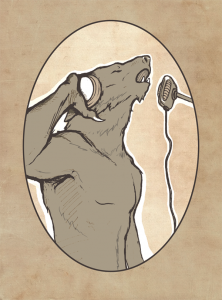An essay by Doctor Silvania Frample, as provided by Andy Brown
Art by Leigh Legler
INTRODUCTION
In the world of Cryptozoology, many creatures are notable for the sounds they make. This study is to explore the potential uses of some of these creatures.
SIRENS
Sirens have been known since the classical period. Their song has the ability to entrance and enslave human listeners. This lulls them into a trance-like state, which allows the Sirens to devour their prey. Since the classical period, the siren gene has been passed down and has appeared as unusually captivating voices. Sarah Vaughn, Billie Holiday, Kate Bush, Dame Nellie Melba, and many other vocalists have been shown to possess the siren gene. Further research will no doubt reveal other examples.
Through our connections, we procured a pure-bred siren. Kept in a sound-proof seclusion tank, we could sample her voice without danger to ourselves.
It was discovered that even the recorded siren call was incredibly powerful. Jeremy Sanderson required extensive therapy–medical, chemical, and psychological–before he was able to return to normality having heard the unadulterated siren song recording.
Weaponising this sound would simply be a case of broadcasting the recorded siren song toward any enemy. The risk is that any hint of the siren song, even at the lowest volume and least intensity, would result in the listener trying to expose his fellows to the sound.
The effect is negligible when experienced by females. Which illustrates the plain and simple fact: males are very easily led.
BEAN SIDHE
The Bean Sidhe has been a feature of Celtic belief for centuries. Their wail is notable for predicting the death of the family of those who hear it.
Our connections obtained a Bean Sidhe. (Ref#155 extra cost for Tesla enclosing cage.)
Its wail was sampled and analysed. Nothing in the signal suggested that it could affect anyone but the listener. The wail was psychologically chilling, as measured by our equipment. Our test subject experienced a physical lowering in temperature and a slowing down of reactions, as if exposed to an extremely low temperature.
Our test subject lost his father the day after our test. There is absolutely no empirical evidence for this event, so we must classify it as a coincidence.
To read the rest of this story, check out the Mad Scientist Journal: Spring 2018 collection.
Doctor Silvania Frample is a cryptozoologist with degrees from Oxford, St Andrew’s, and The Boston College of Cryptophilia. She has been employed by the Invisible University of Maine and the Hidden College of New Boston.
She lives in London and is married with two daughters. The identities of her pets are protected by the Official Secrets Act.
Andy Brown is a musician and entertainer living near Edinburgh in Scotland. (He doesn’t currently own a kilt but does play bagpipes a little.) He is a pleasant enough fellow with a healthy interest in many things and an obsessive interest in many others. (Music, computers, astronomy, reading, writing…) He plays a wide variety of instruments to a wide variety of standards. His greatest happiness is his family and the fact that he wakes every morning still breathing. His greatest sadness is that he might die before warp travel, teleportation, and Klingons are discovered.
Leigh’s professional title is “illustrator,” but that’s just a nice word for “monster-maker,” in this case. More information about them can be found at http://leighlegler.carbonmade.com/.
“Cryptoid Sonics: An Investigation into the Uses of Cryptozoological Sounds” is © 2018 Andy Brown
Art accompanying story is © 2018 Leigh Legler


Dr Frample,
I am quite pleased to see you continuing the research of the prematurely concluded Fourth Experiment.
My own field research in China leads me to believe that what you may have is not a dragon skin drum, but in fact one made from the hide of a Kui, a one-legged bovine native to the mountainous region of Shandong Province in eastern China.
All the best in your continued endeavors.